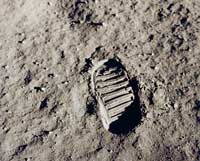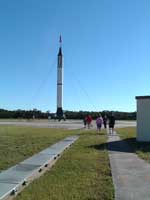
Click here to go to the rum webpage. Here to go to the travel webpage.
We spent a day at Kennedy Space Center, which the locals call "KSC". That sounds a little undignified to my ear, like a fast-food chicken joint. But anyway, the Space Center is divided into the Cape Canaveral launch sites for military hardware and the Kennedy sites for the Space Shuttle and civilian sattelites. Our tour was called something like "NASA-Then and Now", and we saw the older sites from project Mercury, Gemini and Apollo.
The tour started out from the Visitor's Center and went to the space coast at the southern end of the Cape Canaveral Air Force Base. We ended up at the Shuttle launch complex on NASA's Kennedy Center, at the north end of the complex. The first sites showed the stone age of space travel, starting with the sub-orbital Mercury missions at LC5. The launch pads and bunkers looked like something out of World War II. As we went up the coast to the later Gemini launch complexes started to look a little more space age. The last site that we saw on the Canaveral coast was Pad 34, where the Apollo/Saturn 1B launches took place.

Here is a good webpage about Launch Complex 5. This is where the Redstone launches took place. Redstone was the rocket that took America's first astronauts into space in the Mercury capsule. The Redstone was designed to lob nukes over the north pole at the USSR, and they lacked the power to fly orbital missions. In other words, Redstone was a single stage intercontinental ballistic missle. Gus Grissom flew an early Mercury/Redstone mission. Ham the chimp was another passenger of the Redstone. The Redstone was not known for its reliability, and there were times when about half of them blew up on the pad. Naturally, the seven astronauts were a little concerned when they viewed attempted Redstone launches that were explosively unsuccessful.
Pad 34 is the most sophisticated launch complex in the historic section of the Cape. This is where Apollo was born. The lift for the early Apollo spacecraft was provided by the Saturn 1B rocket, which was not capable of putting the Apollo Command & Service Modules into a lunar trajectory. In other words, these were sub-orbital flights.
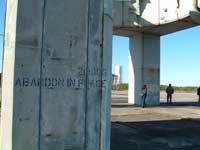
The worst day of the young space program dawned here at Pad 34, on January 27, 1967. A fire on the launch pad destroyed the Apollo I Command module and killed all three astronauts. It still breaks my heart to remember that day. It was a practice run for the new spacecraft, and the men were strapped in for a simulated countdown. The fire started under a panel near the men's feet and flashed through the cockpit before the door could be unbolted. Two design issues prevented rescue: 1) The cabin was pressurized with pure oxygen, which accelerated the blaze. 2) There was no way to open the hatch quickly. It's been reported that the men were dead seventeen seconds after they reported every pilot's nightmare "fire in the cockpit". The door was bolted closed, which was the most reliable way to button up the spacecraft, but there was no way to pop it open in time to fight the fire.
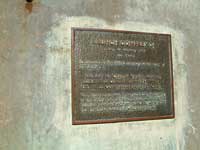
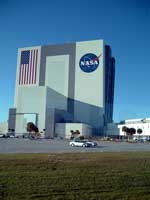
Launch Complex 39 is where the heavy stuff gets pushed into the sky. The mighty Saturn V launched from here during the late '60s and early '70s, putting men on the moon. Now, it's home to the shuttle launches. The complex is built around the two pads, 39A and 39B, plus the hangar where everything is put together. Complex 39 covers a few square miles. The VAB is three miles from the pads, and is connected to them by a freeway-sized road system for the massive crawlers that move the rockets around. Compared to the Mercury/Redstone facility at LC5, LC39 is many orders of magnitude bigger. In a word, Launch Complex 39 is colossal.
Unlike the other launch sites described earlier, his facility is in the Kennedy Space Center. KSC is the civil and commercial part of the Spaceport, and it's run by NASA. The military side is Cape Canaveral Air Force Base.
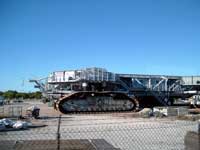
The contrast between LC5 and LC39 is like night & day. A launch technician at LC5 could stand outside the blast door and holler "good luck Alan" as Mr. Shepard stood at the base of his Redstone rocket before a launch. The launch control center for LC39 is within driving distance, but you'd be about three miles from the pad and unable to wish a shuttle mission specialist good luck without a radio link or e-mail. In the few years between Mercury and Apollo, spaceflight changed-big time.
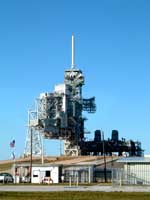
This was one of the highlights of the trip. However, my camera died on me as we entered the firing room. The batteries were shot in the old Binary Wondercam, and that sucks. Anyway, you know that the Saturn V is big, but you don't really get a feel for just how big the launch vehicle really is until you see it. It's a monster. I wish I could see a launch, it must have been spectacular.
Here is a shot of what the firing room looked like during the launch of Apollo 12. The scale of the projest was enormous. There were 400,000 people working on Apollo, including my dad.
